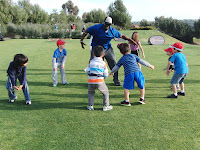Hey Folks!
Recently had a conversation with
Trevor Montgomery, a medical professional from Auckland, NZ, about primitive reflexes. Trevor has been doing some interesting stuff with retained primitive
reflexes as they relate to physical performance - specifically golf performance.
First off, so we're speaking the
same language: PRIMITIVE REFLEXES
are actions that originate in the central nervous
system and are displayed by healthy infants - but not in neurologically-intact
adults - in response to certain stimuli.
These reflexes dissipate through the normal maturation process, giving way to
higher functioning reflexes. Primitive reflexes never leave us. Painful
episodes typically bring them back, enabling us to cope with whatever the
physical ailment may be.
Trevor is a multifaceted
practitioner, well versed in physical therapy, dry needling, acupuncture and
manual manipulation to mention a few. Trevor is a knowledge hound – which is why we love the guy!
He’s always looking for something that will help him improve his ability to
help his clients reach amazing results.
“I saw your post on
primitive reflexes. I have been testing for primitive reflex retention and
sensory processing problems with my golfers (and my other chronic patients) and
getting some stunning results when they are properly overlaid with conscious movement!”
Folks, words like
that are akin to porn right there.
We were hooked! Then
the questions began. How old were they? Were they all healthy? Conceived by
artificial insemination? Did you just get rid of chronic issues? Which were the
more prevalent reflexes? Did you get any of this on video?
 |
| Babinski |
Trevor said he was
tested, finding remnants of 11 of 14 reflexes tested.
“Strongest for me
was a right ATNR, left abdominal, bilateral Babinski, bilateral tendon guard,
left spinal Galant and a Landau,” he said.
 |
| Right ATNR |
In other words folks, if you ever play basketball with Trevor – if these haven’t been taken care of – you, fake a drive to hole, back up and fake again to hit the Babinski, cross him over right-to-left to hit that ATNR and the Galant and give him a belly button poke, hoping Landau jumps out, as you drive to the hole!
 |
| Galant |
“Yep - you would
have pretty much burnt me to the hoop with that!! By the way, I have spent 12
years trying to make my left scap sit in neutral without conscious thought
(despite some serious scap control work) and abolishing 4 of the reflexes that
were driving it down achieved it in a little under 10 minutes.”
Crazy interesting
stuff.
As trainers and
teachers and facilitators of proper movement, we’re all about obtaining
results. Because in the end, results – regardless if they are with a 5-year-old
or a 65-year-old, are what matter most. Trevor’s success with his golfers shows
pretty sweet results.
“If you address the
right reflex, the golfer reports a change after the 30 sec reset,” he said.
“Here's an example. One of my top amateur 17-year-old female golfers couldn't
keep the ulnar aspect of her right hand on the club through to finish. She also
writes like a toddler with her thumb across her fingers (not the adult frogs
legs).
“Reset her grip reflex,
and she immediately held the pen and wrote like an adult and couldn't remember
or repeat how she wrote for the last 12 years! When we put a club in her hand,
she found it easy to keep her whole right hand on the club. Will take her 12
weeks of doing the corrective exercise to make it stick in its entirety but you
should get an immediate change if it is the primary driver for the movement
dysfunction.”
The next day, after a
lesson between the 17-year-old and her coach, Trevor received props from the
coach.
Sweet
stuff there. We’re interested to see what happens from here. Hopefully, Trevor
starts putting of this on video! Hint! Hint! Hint!
Until next time - keep moving the future!











